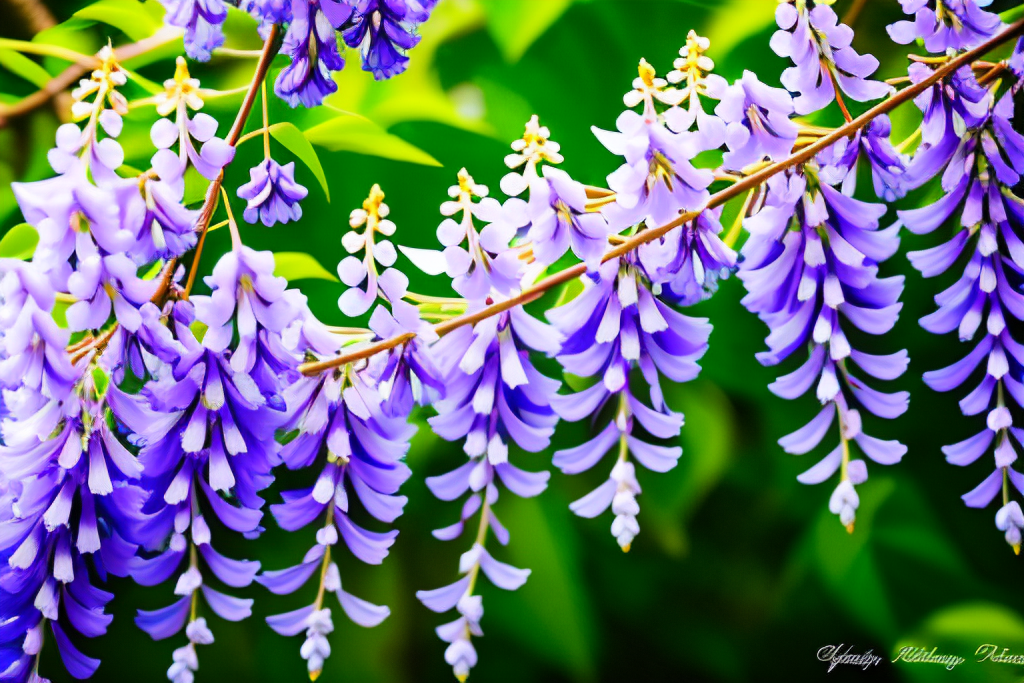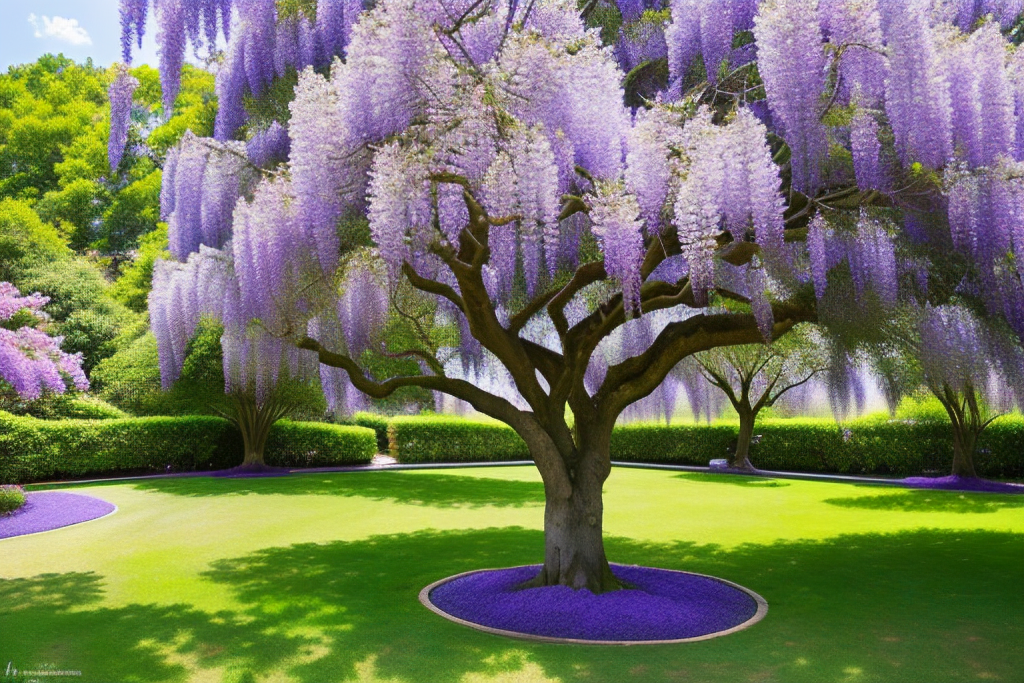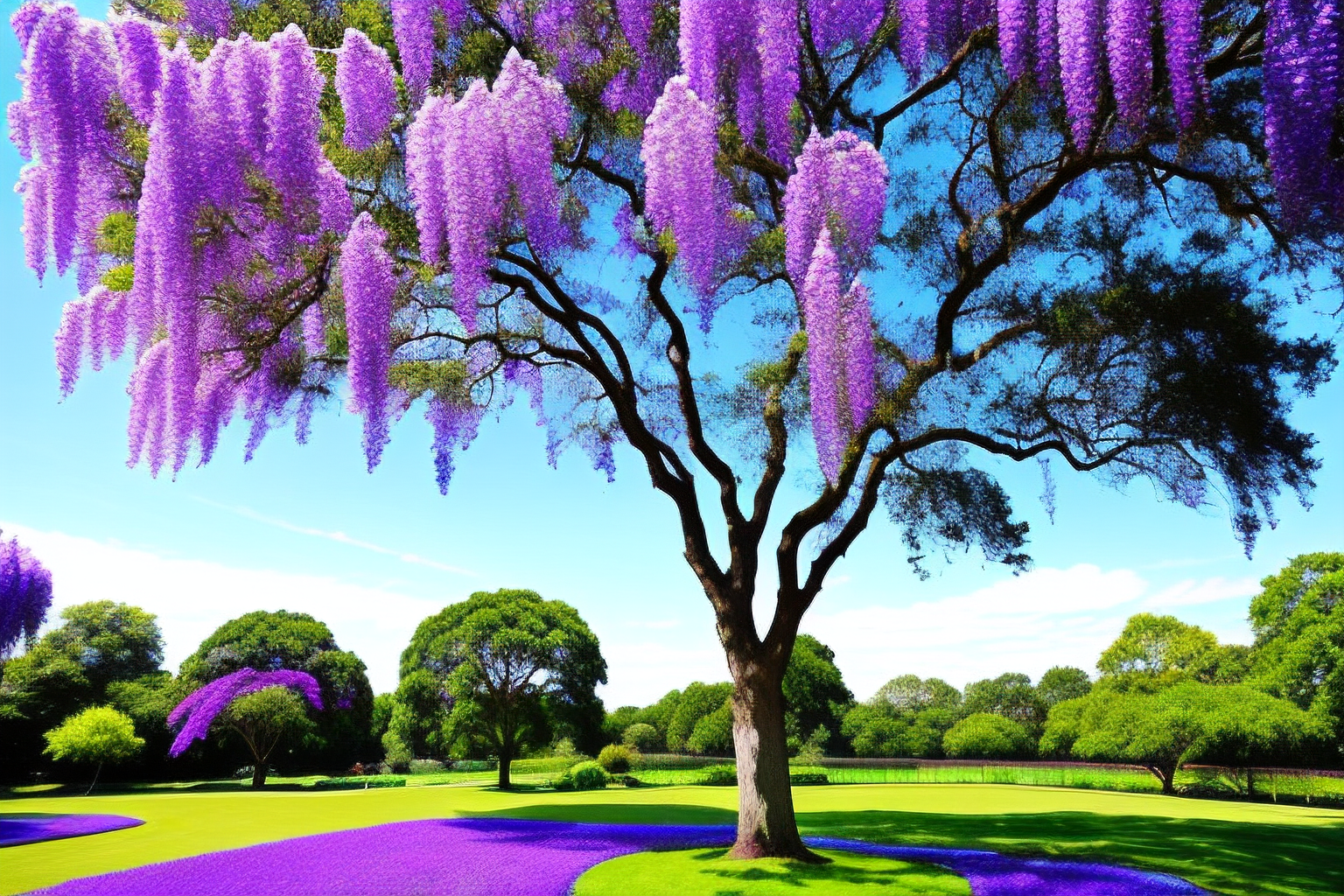Discover the beauty and tranquility of blue Chinese wisteria trees, known for their stunning blooms and graceful presence in gardens and landscapes. These magnificent trees captivate the senses with their vibrant blue flowers, which cascade down in elegant clusters, creating a mesmerizing sight.
Blue Chinese wisteria trees, scientifically known as Wisteria sinensis, are native to China and have been cultivated for centuries for their captivating beauty. They have become a beloved addition to gardens around the world, admired for their enchanting fragrance and the sense of serenity they bring to any outdoor space.
These trees are truly a sight to behold, with their long, cascading branches adorned with delicate blue flowers. The blooms appear in the spring, creating a breathtaking display that is reminiscent of a blue moon, filling the air with a sweet and intoxicating scent.
Whether planted as a standalone tree or trained to grow along a trellis or pergola, blue Chinese wisteria trees add a touch of elegance and charm to any landscape. Their graceful presence and stunning blooms make them a popular choice for gardeners and nature enthusiasts alike.
If you’re looking to create a serene and enchanting garden, consider adding a blue Chinese wisteria tree. With their stunning blooms and graceful presence, these trees are sure to bring beauty and tranquility to your outdoor space.
Origins of Blue Chinese Wisteria Trees

The origins of blue Chinese wisteria trees can be traced back to China, where they are native to. These beautiful trees have a rich history and hold great cultural significance in Chinese gardening traditions. Blue Chinese wisteria trees are known for their stunning blooms and graceful presence, making them a popular choice for gardens and landscapes.
In their native habitat, blue Chinese wisteria trees thrive in temperate regions with mild winters and warm summers. They prefer well-drained soil and plenty of sunlight to flourish. These trees have been cultivated and cherished in China for centuries, with their vibrant blue flowers symbolizing beauty, grace, and the arrival of spring.
Chinese gardeners have long appreciated the elegance and charm of blue Chinese wisteria trees. These trees are often featured in traditional Chinese gardens, where they create a serene and tranquil atmosphere. The cascading blooms of blue Chinese wisteria trees are truly a sight to behold, adding a touch of enchantment to any outdoor space.
Cultivating and Caring for Blue Chinese Wisteria Trees
Cultivating and caring for blue Chinese wisteria trees requires proper knowledge and techniques to ensure their healthy growth and stunning blooms. Here are some essential tips to help you successfully cultivate and care for these beautiful trees:
When planting a blue Chinese wisteria tree, it is important to choose a suitable location that provides full sunlight for at least six hours a day. The soil should be well-draining and rich in organic matter. Before planting, dig a hole that is twice as wide and deep as the root ball. Place the tree in the hole, making sure that the root flare is level with or slightly above the soil surface. Backfill the hole with soil, firming it gently around the roots.
Pruning is crucial for maintaining the health and shape of blue Chinese wisteria trees. It is best to prune the tree during its dormant season, which is late winter or early spring. Start by removing any dead, damaged, or diseased branches. Then, prune back the long, vigorous shoots to encourage branching and more blooms. It is important to regularly prune the tree to prevent it from becoming too dense and to promote better air circulation.
In addition to proper planting and pruning, blue Chinese wisteria trees require regular maintenance to thrive. Water the tree deeply once a week, especially during dry periods. Apply a layer of organic mulch around the base of the tree to help retain moisture and suppress weed growth. Fertilize the tree in early spring with a balanced slow-release fertilizer. Monitor the tree for any signs of pests or diseases, and take appropriate measures to control them.
By following these tips and techniques, you can cultivate and care for blue Chinese wisteria trees successfully, ensuring their beauty and grace adorn your garden or landscape.
Choosing the Right Location
Choosing the right location is crucial for the successful growth and development of blue Chinese wisteria trees. These stunning trees require specific growing conditions and suitable locations to thrive and produce their vibrant blooms. Here are some factors to consider when selecting the perfect spot for your blue Chinese wisteria tree:
- Sunlight: Blue Chinese wisteria trees thrive in full sun, so choose a location that receives at least 6-8 hours of direct sunlight each day. This will ensure optimal growth and abundant flowering.
- Soil type: These trees prefer well-draining soil that is rich in organic matter. Avoid heavy clay soils that can retain excess moisture, as this can lead to root rot. Loamy or sandy soils are ideal for blue Chinese wisteria trees.
- Space requirements: Blue Chinese wisteria trees are vigorous climbers and can reach impressive sizes. Make sure to provide enough space for the tree to grow and spread its branches. Consider the ultimate height and width of the tree when selecting a location.
Additionally, it’s important to consider the surrounding landscape and other plants in the vicinity. Blue Chinese wisteria trees can be trained to grow on arbors, pergolas, or trellises, providing a stunning focal point in your garden. The cascading flowers create a breathtaking display that can be enjoyed from below or above.
By carefully considering these factors, you can ensure that your blue Chinese wisteria tree thrives in its chosen location, bringing beauty and elegance to your outdoor space.
Pruning Techniques for Optimal Blooms
Pruning is an essential practice for maintaining the health and beauty of blue Chinese wisteria trees. By following the right pruning techniques, you can promote optimal blooms and ensure a stunning display of cascading flowers.
One important aspect of pruning blue Chinese wisteria trees is timing. It is best to prune them during the dormant season, which is typically in late winter or early spring. This allows the tree to focus its energy on new growth and flower production.
When pruning, start by removing any dead, damaged, or diseased branches. This helps prevent the spread of diseases and encourages healthy growth. Additionally, thin out the branches to improve air circulation and sunlight penetration, which are crucial for the tree’s overall health.
Another pruning technique for optimal blooms is training the tree’s shape. Blue Chinese wisteria trees can be trained to grow in various forms, such as a standard tree or a cascading vine. By carefully pruning and shaping the branches, you can achieve the desired form and enhance the visual appeal of the tree.
It is also important to prune the tree after it has finished blooming. This helps remove any spent flowers and encourages the development of new buds for the next blooming season. Be careful not to prune too heavily, as this can reduce flower production.
Overall, proper pruning techniques play a crucial role in promoting healthy growth and abundant blooms in blue Chinese wisteria trees. By following these techniques, you can ensure a breathtaking display of cascading flowers and enjoy the serenity that these trees bring to your garden or landscape.
Preventing Common Pests and Diseases

When it comes to blue Chinese wisteria trees, it’s important to be aware of the common pests and diseases that can pose a threat to their health and vitality. By taking proactive measures and implementing effective prevention methods, you can ensure that your blue Chinese wisteria tree thrives for years to come.
One common pest that can affect blue Chinese wisteria trees is aphids. These tiny insects feed on the tree’s sap and can cause damage to the leaves and stems. To prevent aphids from infesting your tree, you can introduce natural predators such as ladybugs or use insecticidal soaps or oils to control their population.
In addition to aphids, blue Chinese wisteria trees can also be susceptible to fungal diseases such as powdery mildew. This fungal infection appears as a white powdery coating on the leaves and can hinder the tree’s growth and overall health. To prevent powdery mildew, ensure proper air circulation around the tree by pruning it regularly and avoiding overwatering. Applying a fungicide can also help control and prevent the spread of this disease.
Another common issue that can affect blue Chinese wisteria trees is root rot, which is caused by excessive moisture and poor drainage. To prevent root rot, make sure to plant your tree in well-draining soil and avoid overwatering. Regularly inspect the roots for any signs of rot or decay and take necessary steps to address the issue promptly.
By being vigilant and taking preventive measures against common pests and diseases, you can ensure that your blue Chinese wisteria tree remains healthy and vibrant, providing you with years of beauty and enjoyment.
Symbolism and Cultural Significance
Blue Chinese wisteria trees hold deep symbolism and cultural significance in various aspects of Chinese culture. These enchanting trees have been a source of inspiration for artists, writers, and poets for centuries. In art and literature, blue Chinese wisteria trees symbolize beauty, grace, and the arrival of spring. Their delicate and cascading flowers are often depicted in paintings and poetry, capturing the essence of nature’s elegance.
Moreover, blue Chinese wisteria trees play a significant role in traditional Chinese celebrations. One such celebration is the Lantern Festival, where these trees are admired for their vibrant colors and enchanting fragrance. During this festival, blue Chinese wisteria trees are illuminated with lanterns, creating a mesmerizing sight for all to behold. The presence of these trees symbolizes joy, prosperity, and the renewal of life.
In Chinese culture, blue Chinese wisteria trees are also associated with longevity and good fortune. It is believed that having these trees in one’s garden or home brings luck and blessings. Their graceful presence and stunning blooms create a sense of serenity and tranquility, making them a beloved choice for gardens and landscapes.
Overall, blue Chinese wisteria trees are not only admired for their beauty but also revered for their cultural significance. They represent the harmony between humans and nature, the celebration of life, and the appreciation of art and literature. These trees continue to captivate hearts and minds, leaving a lasting impression on all who encounter their breathtaking blooms.
Symbolism in Chinese Art and Literature
Symbolism in Chinese Art and Literature
Chinese art and literature have long celebrated the beauty and symbolism of blue Chinese wisteria trees. These majestic trees are often depicted in paintings, poetry, and other forms of artistic expression, symbolizing various aspects of nature and human emotions.
In Chinese art, the blue Chinese wisteria tree is often portrayed as a symbol of beauty and grace. Its cascading blooms, with their vibrant blue hues, are seen as a representation of elegance and refinement. Artists use the tree’s graceful form and delicate flowers to create visually stunning compositions that evoke a sense of tranquility and harmony.
Similarly, in Chinese literature, blue Chinese wisteria trees are often used as metaphors for the arrival of spring and the renewal of life. The blooming of these trees is seen as a sign of hope and new beginnings. Poets and writers use vivid descriptions of the tree’s vibrant colors and intoxicating fragrance to capture the essence of the changing seasons and the beauty of nature.
Overall, blue Chinese wisteria trees hold a special place in Chinese art and literature, symbolizing not only the beauty of the natural world but also the emotions and aspirations of the human spirit.
Blue Chinese Wisteria Trees in Traditional Celebrations
Blue Chinese Wisteria Trees hold a significant role in traditional Chinese celebrations, particularly in the enchanting Lantern Festival. This festival, celebrated on the fifteenth day of the first lunar month, is a time when families gather to admire the beauty of lantern displays and enjoy various cultural activities.
During the Lantern Festival, blue Chinese wisteria trees are prominently displayed for their vibrant colors and captivating fragrance. These trees symbolize beauty, grace, and the arrival of spring, making them a perfect addition to the festive atmosphere. The cascading blooms of blue wisteria create a mesmerizing sight, adding a touch of elegance to the celebrations.
As visitors stroll through the lantern-lit streets, the enchanting fragrance of blue Chinese wisteria fills the air, creating a magical ambiance. The vibrant blue hue of the wisteria flowers adds a splash of color to the festivities, enhancing the overall visual appeal.
Whether used as decorations or admired for their natural beauty, blue Chinese wisteria trees play a significant role in creating an unforgettable experience during traditional Chinese celebrations. Their presence adds a touch of serenity and charm, making the Lantern Festival an even more memorable occasion.










